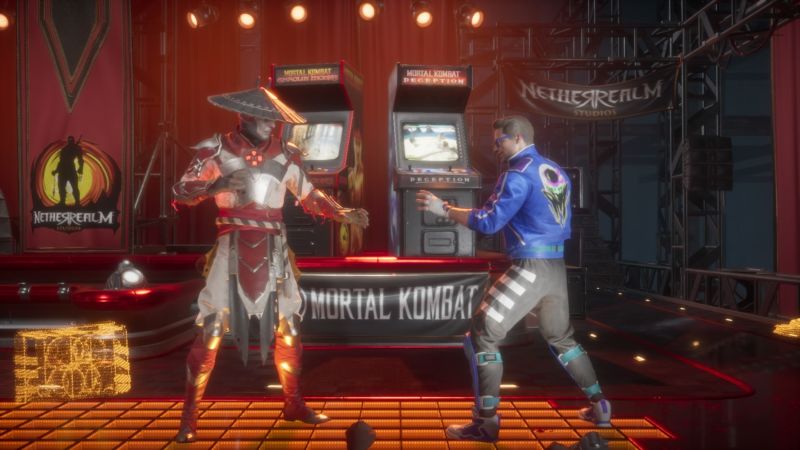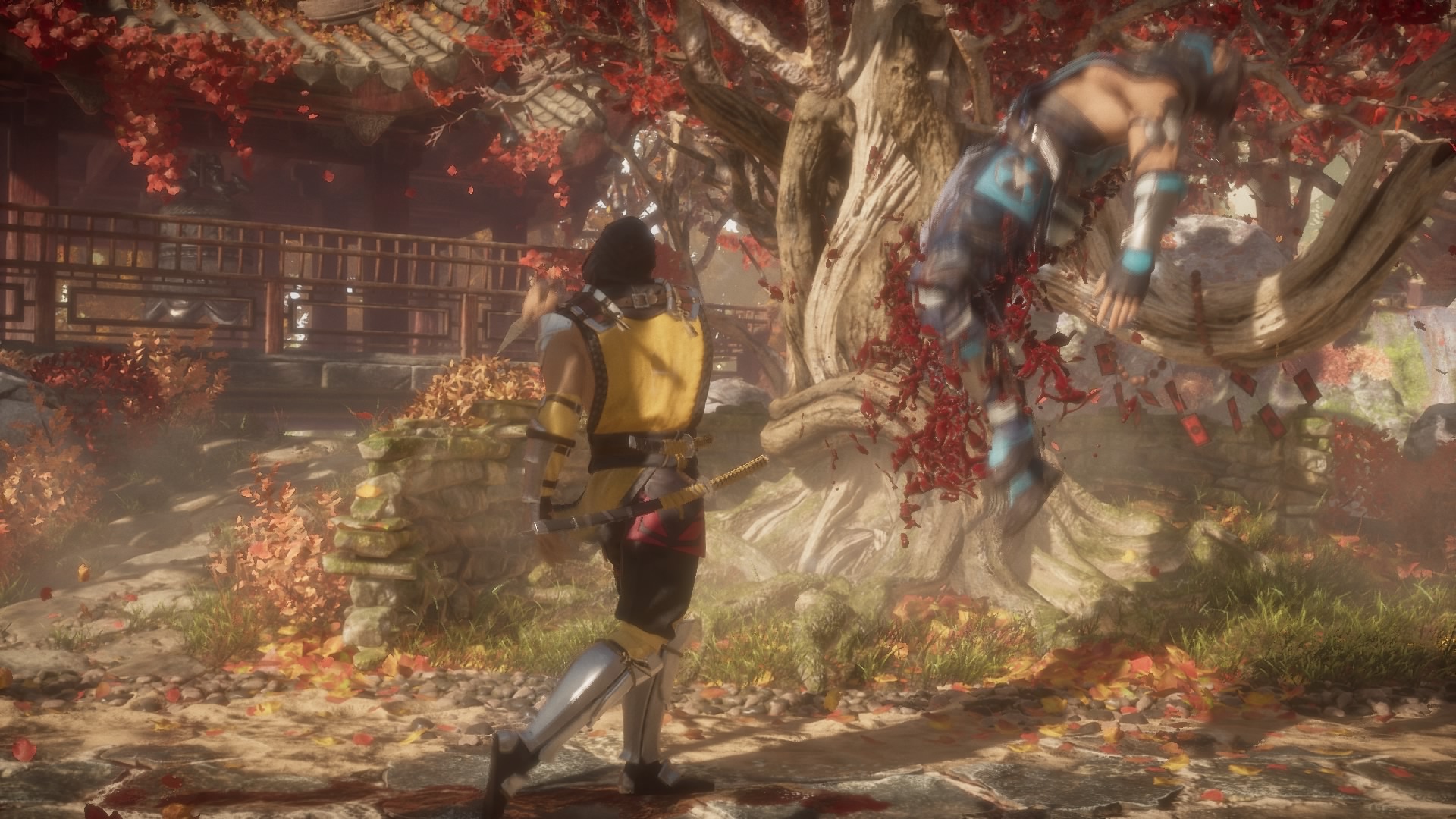
The original Mortal Kombat was part of the arcade experience that quite literally shaped my life in gaming—I've been a dedicated fighting game community member ever since. Looking back, the entire original trilogy of games feels special, and the early-year hype for Mortal Kombat 11 recently stirred up some of that nostalgia. After a long time of mostly ignoring the franchise's releases, I was genuinely looking forward to trying a new Mortal Kombat game.
As a somewhat serious fighting game player, I'm good enough to know I'm not particularly good. Fighting games are a pretty deep rabbit hole, and there is always more to dig. I'm registered to compete this August in Street Fighter V and the new (and still unreleased) Samurai Shodown at Evo, the annual global fighting game event in Vegas. I run a weekly night hosting players for a multitude of fighting games (but mostly Street Fighter titles). No matter the preferred title, though, I'm happy to nerd out and talk frame traps or fighting game theory.
I'm a fan of the Mortal Kombat series in general, but I stopped paying much attention after the third arcade title in the mid '90s. So before playing MK11, I caught up on some quick summaries of the rebooted franchise lore that came along with NetherRealm Studios' (NRS) Mortal Kombat 9 in 2011. My perspective on the game may very much be that of a lapsed fan these days, but those early titles will always hold a special place.
With all that out of the way, I'll say that Mortal Kombat 11 gives me mixed feelings.
Visual feast

To begin with, the game is gorgeous. NRS is using a highly modified version of the Unreal Engine 3, and whatever the studio has done makes the game outshine Unreal Engine 4 fighters like Tekken 7 and Street Fighter V in graphic fidelity. Everything from the character models and stages to the lighting and effects oozes high-budget polish. The blood and viscera (we'll get to that!) have never looked so shiny and fluid.
The stage designs might be my favorite part. There's a broad variety of locations, from a ship sailing a blood-tossed sea, to a desert-housed military base complete with a cactus you can scrub your opponent's face on, to a throwback to the original Mortal Kombat tournament stage with the audience of orange-robed Shaolin monks—except this time they're silent corpses instead of a sea of bobbing heads.
Mortal Kombat has always been a series that emphasized atmosphere, and this might be its strongest atmosphere yet. Smoke and dust swirl in the backgrounds, candles glow softly, and interactable elements (like the aforementioned cactus) give each stage a little extra personality.
The character designs are great, too, with a varied mix of both visual and play styles. The bulk of the cast are old favorites, such as Scorpion, Sub Zero, and Raiden, but there are a few newer NRS-era characters, like the blood-magic-wielding Skarlet and Cassie Cage, daughter of Johnny Cage and Sonya Blade (her parents are in the game, too). Yeah, the game is old enough that the original characters have hooked up to have kids. There's also a handful of interesting newcomers, like Geras, who can manipulate time, or the six-armed Kollector, who has so many limbs he dedicates two just for holding up his backpack.
The original MK games were made using digitized actors to create all of the poses, creating a much more "realistic" style at the time compared to the more cartoony Street Fighter. Now NRS uses 3D models, but it still relies heavily on motion capture to help animate them and serve as a link back to the tech that started the series off. This has been a mixed success on previous titles, which were deservedly criticized for some odd poses and choices. MK11 is much improved in that department, but it still retains a bit of a stiff feeling that stems all the way back to the original games. It feels like it's 80-percent a stylistic choice but 20-percent just plain-old bad animation. That's an improvement over past games like Mortal Kombat X and Injustice 2, though, where the ratio was maybe 50/50, to be kind.
Overall, even taking into account the occasional wonky animation choice, MK11 is easily the best looking "realistic" 3D fighter on the market. Games like Dragon Ball Fighterz or Guilty Gear, which are rendered in 3D, but with cel shading techniques, stand out for their style, but if you're looking for finely rendered skeletons of four-armed, half-human half-dragons (RIP Goro), NRS is on top of the pile.

Fatal blows
All this graphic fidelity of course leads us to the thing the series is most known for: excessive gore and violence. Mortal Kombat has always been an adolescent fantasy series—with undead ninja assassins, Shaolin monks, femme fatales, and lightning gods—but it's the fatalities that really put it on the map. You could tear someone's head off after defeating them, then hold it aloft as the spine dangles below. It was a bit exaggerated, but the graphics were realistic for their time.
MK11 turns the blood up to 11 and really makes the most of the graphic engine. Want to rip someone's face off, smash their skull open, and jab their brain out on your arm spike so you can take a big, juicy bite of it while blood gushes out in slow motion and you mug for the camera? NRS has got you covered. How about vomiting up a torrent of bugs into your victim's mouth, so they can writhe in pain before erupting into a mass of legs, the corpse now being worn like a hermit crab's shell? No problem!
The time-manipulating boss of the story repeatedly rips you in half, or flays the skin from your body, then reverses time to do it all over again. If you can think of a way to tear someone apart, chances are good the game has you covered.
The violence and sadism are excessive, but that's what the series is known for. Every character has two overly involved fatalities, as well as an assortment of shorter kill animations called brutalities. Of the latter, my personal favorite so far is crushing your opponent under a falling Mortal Kombat arcade cabinet in a nice series callback. It's gross but mostly in good fun, certainly part of the Mortal Kombat package.
With MK11, I have two real complaints about the lack of restraint shown by the game's tendency to go overboard. The first and largest issue involves a new mechanic for the series, called a Fatal Blow.
A Fatal Blow is a move you can do once a match that becomes available when your character drops below 30-percent health. It's a comeback mechanic, meant to give the losing player a chance to strike back. I'm not a giant fan of things that reward people for losing, but making it only work once a match means there's some strategy to when you employ it, at least.
The problem is that the animation triggered by a Fatal Blow is so long. The name is a misnomer: it's not a blow, it's a whole series of them. Johnny Cage, for instance, starts with his glowing green shadow kick, right to the chin, slow-motion blood flying from his opponent's mouth. Next come some more kicks and flips, this time slamming the victim to the ground, his boot to the head, more slow-motion blood flying out. He's not done, though; now he's whipping out his Oscar-look-alike trophy, holding it aloft to let the light gleam off it, before reaching down to smash it across the opposing face. Even that's not enough, as Cage finally leaps back, grips the trophy, and stabs it into his foe's chest, with, you guessed it, more slow-motion blood flying everywhere.
The whole thing takes a whopping 12 seconds to complete. That might not sound like a lot, but keep in mind this is an essential game mechanic you're likely to see every single match (sometimes twice a match). Those slow animations add up fast when repeated ad nauseam.
Fatalities are optional, only happening after the match is over. Between multiple fatalities and brutalities, there's also a decent amount of variety. Fatal Blows, on the other hand, are a core mechanic that plays out as the same long sequence every time. They get old very fast, there's no way to skip through them, and they happen mid-match, really killing the flow of the action. I found myself avoiding using my Fatal Blow against the CPU during fights when I was confident I didn't need it to win, simply because I didn't feel like sitting through the animation again.
If the current roughly 12-second Fatal Blows had been divided up into six individual two-second options, randomly selected each time, it would have felt much more satisfying and snappy. As it is, it's easily my least favorite aspect of the gameplay.
-
Scorpion beheading and spearing his arch rival, Sub Zero
-
Cassie Cage kicking her mother so hard in the chest her heart flies out.
-
D'Vorah's fatality begins with her vomiting bugs into her opponent's mouth.
-
Baraka ripping off someone's face.
-
After the face ripping comes the brain nom nom nomming.
-
Kotal Kahn dropping an idol on his opponent's head.
-
Liu Kang, looking a bit gray in his undead 'Revenant' state, punches his foe to literal bits.
The other place the lack of restraint shows through is an ironic result of the care and depth NRS has put into its characters. The long and generally well-crafted story mode offers a lot of chances to build real personalities and feeling into each protagonist. They deal with loss and sadness and family in a relatable way.
And that makes it much more jarring when they sadistically torture each other.
The opening of the story has a fight scene between Cassie and her mother, Sonya, billed as a rite of passage for Cassie's military promotion. That works as a good excuse for a fight scene. You get to control Cassie, putting a little hurt on her mom. Wait, huh? Cassie, why are you picking up that power tool? Holy crap, you just jammed it into your mother's head and started drilling her brain out, blood is flying everywhere. I thought this was a friendly fight? That's messed up, girl.
At one point in the story, a character takes a bullet to the leg. He can't fight anymore; they have to help him out. It's very dramatic. He's also the guy who was getting half disemboweled earlier, with spikes jammed through his head, bullets bouncing off coins and into his eyes, and just generally getting ripped to shreds. The disconnect between when the blood matters or not is kinda funny, but it also removes a lot of the story tension.
Even outside of the story, things get weird in MK11 with the story mode. You can't perform fatalities during story fights, against your family members or otherwise. But in a normal versus match? It might seem like a quibble in a game so awash in violence, but it's a little extra weird to see Cassie kick a hole in her father's chest, sending his heart flying, and then pose behind the gaping wound to make a heart with her hands and send a kiss to the camera.
Mortal Kombat and excessive violence had gone hand in hand from the start. But MK11 can feel like it's trying too hard, with animations that start to feel dragged out and forced. More respect for the viewer's time would have been nice. Ending a match with a long Fatal Blow and then getting the invitation to perform the fatality right after can feel like the Simpsons meme: "Stop, stop! He's already dead!"
Reader Comments (105)
View comments on forumLoading comments...